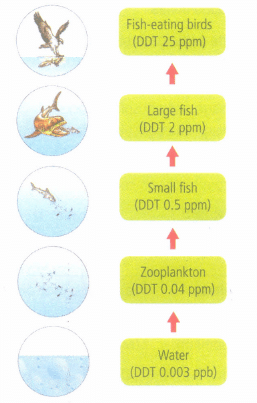Test: Water Pollution (Old NCERT) - NEET MCQ
20 Questions MCQ Test Biology Practice Tests: CUET Preparation - Test: Water Pollution (Old NCERT)
Given figure represents biomagnification of DDT in an aquatic food chain. Select the incorrect statement regarding this.

A higher biochemical oxygen demad in a particular segment of a river indicates that
| 1 Crore+ students have signed up on EduRev. Have you? Download the App |
The amount of biodegradable organic matter in sewage water can be estimated by measuring
High concentration of nutrients especially nitrates and phosphates in water can accelerate which of the following phenomenon?
Which of the following statements is not correct regarding algal blooms?
Which of the following statements is not correct regarding biomagnification?
(i) Mercury accumulated by an organism cannot be metabolised.
(ii) In the process of biomagnification, concentration of DDT is increased at successive trophic levels.
(iii) Accumulation of cadmium can cause thinning of egg shell in birds.
(iv) DDT accumulation is a major cause of reduced population of fish eating birds.
(v) Biomagnification occurs only in aquatic food chain.
Contamination of water sewage is indicated by cysts of
Escherichia coli is used as an indicator organism to determine pollution of water with
A lake with an inflow of domestic sewage rich in organic waste may result in
Minamata disease was caused due to the consumption of
A lake near a village suffered heavy mortality of fishes within a few days. Which of the following statements could be the correct explanation for this?
(i) Lots of urea and phosphate fertillisers were used in the crops in the nearby fields.
(ii) The croplands of the village were fertillised fields rich in nitrate and phosphate.
(iii) The lake water turned green and stinky.
(iv) Phytoplankton populations in the lake declined initially thereby greatly reducing photosynthesis.
DDT residues are rapidly passed through food chain causing biomagnification because DDT is
Which among the following is likely to have the highest levels of DDT deposition in its body?
A dental disease characterized by mottling of teeth is due to presence of a certain chemical element in drinking water. Which is that element?
Given below are four statements each with two blanks. Select the option which correctly fills up the blank in any two statements.
(i) Bhopal gas disaster took place on____ 1984 and this day is now observed as the____ day in India to make the anniversary of the Bhopal gas disaster.
(ii) ____ is a biodegradable pollutant while_____ is a non-biodegradable pollutant.
(iii) When pollutants are released from a single point it is called____ pollution, but when it is over a large area, then it is called____ pollution.
(iv) ___ is the world's most problematic aquatic weed, introduced in India for its lovely flowers, also called a s ____ .
A disease caused by eating fish contaminated by industrial waste, containing mercury compounds, is called as

















